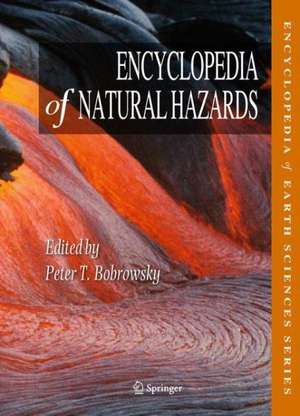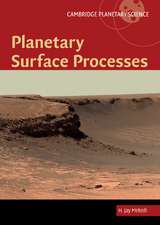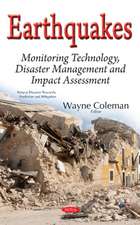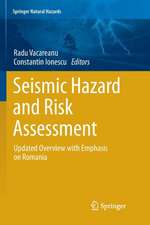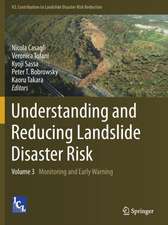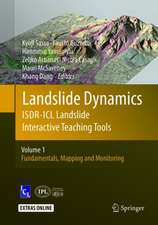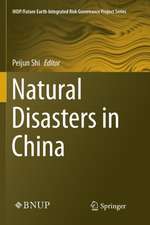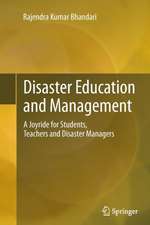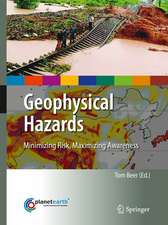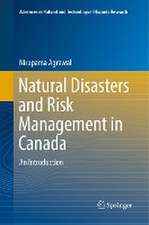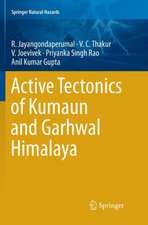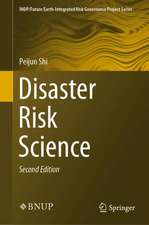Encyclopedia of Natural Hazards: Encyclopedia of Earth Sciences Series
Pedro Basabe Editat de Peter T. Bobrowsky Tom Beer, Norm Catto, Viacheslav Gusiakov, Bill McGuire, H. Jay Melosh, Farrokh Nadim, Philipp Schmidt-Thomé, Paul Slovicen Limba Engleză Hardback – 3 apr 2013
Few subjects share the true interdisciplinary dependency that characterizes the field of natural hazards. From geology and geophysics to engineering and emergency response to social psychology and economics, the study of natural hazards draws input from an impressive suite of unique and previously independent specializations. Natural hazards provide a common platform to reduce disciplinary boundaries and facilitate a beneficial synergy in the provision of timely and useful information and action on this critical subject matter.
As social norms change regarding the concept of acceptable risk and human migration leads to an explosion in the number of megacities, coastal over-crowding and unmanaged habitation in precarious environments such as mountainous slopes, the vulnerability of people and their susceptibility to natural hazards increases dramatically. Coupled with the concerns of changing climates, escalating recovery costs, a growing divergence between more developed and less developed countries, the subject of natural hazards remains on the forefront of issues that affect all people, nations, and environments all the time.
This treatise provides a compendium of critical, timely and very detailed information and essential facts regarding the basic attributes of natural hazards and concomitant disasters. The Encyclopedia of Natural Hazards effectively captures and integrates contributions from an international portfolio of almost 300 specialists whose range of expertise addresses over 330 topics pertinent to the field of natural hazards. Disciplinary barriers are overcome in this comprehensive treatment of the subject matter. Clear illustrations and numerous color images enhance the primary aim to communicate and educate. The inclusion of a series of unique “classic case study” events interspersed throughout the volume provides tangible examples linking concepts, issues, outcomes and solutions. These case studies illustrate different but notable recent, historic and prehistoric events that have shaped the world as we now know it. They provide excellent focal points linking the remaining terms in the volume to the primary field of study. This Encyclopedia of Natural Hazards will remain a standard reference of choice for many years.
Din seria Encyclopedia of Earth Sciences Series
- 18%
 Preț: 2462.97 lei
Preț: 2462.97 lei - 18%
 Preț: 2775.45 lei
Preț: 2775.45 lei - 18%
 Preț: 3104.38 lei
Preț: 3104.38 lei - 18%
 Preț: 2451.92 lei
Preț: 2451.92 lei - 18%
 Preț: 2819.01 lei
Preț: 2819.01 lei - 18%
 Preț: 2459.80 lei
Preț: 2459.80 lei - 18%
 Preț: 2752.60 lei
Preț: 2752.60 lei - 18%
 Preț: 2733.95 lei
Preț: 2733.95 lei - 18%
 Preț: 1901.16 lei
Preț: 1901.16 lei - 18%
 Preț: 2831.47 lei
Preț: 2831.47 lei - 18%
 Preț: 2520.24 lei
Preț: 2520.24 lei - 18%
 Preț: 2808.65 lei
Preț: 2808.65 lei - 24%
 Preț: 2779.63 lei
Preț: 2779.63 lei - 24%
 Preț: 2672.29 lei
Preț: 2672.29 lei - 18%
 Preț: 2140.88 lei
Preț: 2140.88 lei - 24%
 Preț: 3329.20 lei
Preț: 3329.20 lei - 18%
 Preț: 3286.72 lei
Preț: 3286.72 lei - 24%
 Preț: 2502.41 lei
Preț: 2502.41 lei - 18%
 Preț: 2541.22 lei
Preț: 2541.22 lei - 24%
 Preț: 2449.16 lei
Preț: 2449.16 lei - 24%
 Preț: 1611.08 lei
Preț: 1611.08 lei - 24%
 Preț: 2188.68 lei
Preț: 2188.68 lei - 14%
 Preț: 2198.26 lei
Preț: 2198.26 lei - 9%
 Preț: 1677.82 lei
Preț: 1677.82 lei - 14%
 Preț: 1632.58 lei
Preț: 1632.58 lei - 14%
 Preț: 1849.21 lei
Preț: 1849.21 lei - 14%
 Preț: 2571.39 lei
Preț: 2571.39 lei - 14%
 Preț: 1945.49 lei
Preț: 1945.49 lei - 14%
 Preț: 1945.49 lei
Preț: 1945.49 lei - 14%
 Preț: 1945.49 lei
Preț: 1945.49 lei - 14%
 Preț: 1945.49 lei
Preț: 1945.49 lei - 9%
 Preț: 2703.12 lei
Preț: 2703.12 lei - 14%
 Preț: 1945.49 lei
Preț: 1945.49 lei - 14%
 Preț: 1945.49 lei
Preț: 1945.49 lei - 14%
 Preț: 2130.86 lei
Preț: 2130.86 lei
Preț: 2471.47 lei
Preț vechi: 3013.98 lei
-18% Nou
Puncte Express: 3707
Preț estimativ în valută:
473.04€ • 491.98$ • 396.41£
473.04€ • 491.98$ • 396.41£
Carte disponibilă
Livrare economică 20 februarie-06 martie
Preluare comenzi: 021 569.72.76
Specificații
ISBN-13: 9789048186990
ISBN-10: 9048186994
Pagini: 1135
Ilustrații: XLI, 1135 p. 479 illus., 336 illus. in color.
Dimensiuni: 210 x 279 x 55 mm
Greutate: 3.47 kg
Ediția:2013
Editura: SPRINGER NETHERLANDS
Colecția Springer
Seria Encyclopedia of Earth Sciences Series
Locul publicării:Dordrecht, Netherlands
ISBN-10: 9048186994
Pagini: 1135
Ilustrații: XLI, 1135 p. 479 illus., 336 illus. in color.
Dimensiuni: 210 x 279 x 55 mm
Greutate: 3.47 kg
Ediția:2013
Editura: SPRINGER NETHERLANDS
Colecția Springer
Seria Encyclopedia of Earth Sciences Series
Locul publicării:Dordrecht, Netherlands
Public țintă
GraduateCuprins
AA-LAVA.- Accelerometer.- Acid Rain.- Adaptation.- Airphoto and Satellite Imagery.- Albedo.- Antecedent Conditions.- Arsenic in Groundwater.- Asteroid.- Asteroid Impact.- Asteroid Impact Mitigation.- Asteroid Impact Predictions.- Automated Local Evaluation in Real Time (ALERT).- Avalanches.- Aviation (Hazards to).- Avulsion.- Base Surge.- Beach Nourishment (Replenishment).- Beaufort Wind Scale.- Biblical Events.- Body Wave.- Breakwaters.- Building Code.- Building Failure.-
Buildings, Structures, and Public Safety.- Calderas.- Casualties Following Natural Hazards.- Challenges to Agriculture.- Civil Protection and Crisis Management.- Classification of Natural Disasters.- Climate Change.- Cloud Seeding.- Coal Fire (Underground).- Coastal Erosion.- Coastal Zone Risk Management.- Cognitive Dissonance.- Collapsing Soil Hazards.- Comet.- Communicating Emergency Information.- Community Management of Natural Hazards.- Complexity Theory.- Concrete Structures.- Convergence.- Coping Capacity.- Cost-Benefit Analysis of Natural Hazard Mitigation.- Costs (Economic) of Natural Hazards and Disasters.- Creep.- Critical Incident Stress Syndrome.- Critical Infrastructure.- Cryological Engineering.- Cultural Heritage and Natural Hazards.- Damage and the Built Environment.- Debris Avalanche.- Debris Flow.- Deep-seated Gravitational Slope Deformation.- Desertification.- Disaster Diplomacy.- Disaster Relief.- Disaster Research and Policy, History.- Disaster Risk Management.- Disaster Risk Reduction.- Disasters.- Dispersive Soil Hazards.- Doppler Weather Radar.- Dose Rate.- Drought.- Dust Bowl.- Dust Devil.- Dust Storm.- Dvorak Classification of Hurricanes.- Early Warning Systems.- Earthquake.- Earthquake Damage.- Earthquake Prediction and Forecasting.- Earthquake Resistant Design.- Economic Valuation of Life.- Economics of Disasters.- Education and Training for Emergency Preparedness.- Elastic Rebound Theory.- Electromagnetic Radiation (EMR).- El Niño/Southern Oscillation.- Emergency Management.- Emergency Mapping.- Emergency Planning.- Emergency Shelter.- Epicenter.- Epidemiology of Disease in Natural Disasters.- Erosion.- Erosivity.- Eruption Types (Volcanic Eruptions).- Evacuation.- Expansive Soils and Clays.- Expert (Knowledge-Based) Systems for Disaster Management.- Exposure to Natural Hazards.- Extensometers.- Extinction.- Extreme Value Theory.- Eyjafjallajökull Eruptions 2010.- Fault.- Federal Emergency Management Agency (FEMA).- Fetch.- Fire and Firestorms.- Flash Flood.- Flood Deposits.- Flood Hazard and Disaster.- Flood Protection.- Flood Stage.- Floodplain.- Floodway.- Fog Hazard Mitigation.- Fog Hazards.- Föhn.- Forest and Range Fires.- Frequency and Magnitude of Events.- Frost Hazard.- Fujita Tornado Scale.- Fumarole.- Galeras Volcano, Colombia.- Gas-Hydrates.- Geographic Information Systems (GIS) and Natural Hazards.- Geographic Information Technology.- Geohazards.- Geological/Geophysical Disasters.- Glacier Hazards.- Global Change and its Implications for Natural Disasters.- Global Dust.- Global Network of Civil Society Organizations for Disaster Reduction.- Global Positioning Systems (GPS) and Natural Hazards.- Global Seismograph Network (GSN).- Haiti Earthquake 2010: Psychosocial Impacts.- Harmonic Tremor.- Hazard.- Hazard and Risk Mapping.- Hazardousness of a Place.- Heat Waves.- High-Rise Buildings in Natural Disaster.- Historical Events.- Hospitals in Disaster.- Human Impacts of Hazards.- Humanity as an Agent of Natural Disasters.- Hurricane (Typhoon, Cyclone).- Hurricane Katrina.- Hydrocompaction Subsidence.- Hydrograph, Flood.- Hydrometeorological Hazards.- Hyogo Framework for Action 2005-2015.- Hypocenter.- Ice and Icebergs.- Ice Storms.- Impact Airblast.- Impact Ejecta.- Impact Fireball.- Impact Firestorms.- Impact Tsunamis.- Impact Winter.- Inclinometers.- Indian Ocean Tsunami, 2004.- Induced Seismicity.- Information and Communication Technology.- Insect Hazards.- Insurance.- Integrated Emergency Management System.-Intensity Scales.- International Strategies for Disaster Reduction (IDNDR and ISDR).- Internet, World Wide Web and Natural Hazards.- Isoseismal.- Jökulhlaups.- Karst Hazards.- Krakatoa (Krakatau).- Lahar.- Land Degradation.- Land Subsidence.- Land Use, Urbanization, and Natural Hazards.- Landsat Satellite.- Landslide.- Landslide Dam.- Landslide Impacts.- Landslide Inventory.- Landslide Triggered Tsunami, Displacement Wave.- Landslide Types.- Land-Use Planing.- Lateral Spreading.- Lava.- Levee.- Lightning.- Liquefaction.- Livelihoods and Disasters.- Loess.- Macroseismic Survey.- Magma.- Magnitude Measures.- Marginality.- Marine Hazards.- Mass Media and Natural Disasters.- Mass Movement.- Megacities and Natural Hazards.- Mega-Fires in Greece (2007).- Mercalli, Giuseppe (1850-1914).- Meteorite.- Methane Release from Hydrate.- Mining Subsidence Induced Fault Reactivation.- Misconceptions About Natural Disaster.- Mitigation.- Modified Mercalli (MM) Scale.- Monitoring Natural Hazards.- Monsoons.- Montserrat Eruptions.- Mortality and Injury in Natural Disasters.- Mt Pinatubo.- Mud Volcanoes.- Mudflow.- Myths and Misconceptions in Disasters.- Natural Hazard.- Natural Hazards in Developing Countries.- Natural Radioactivity.- Neotectonics.- Nevado del Ruiz Volcano, Colombia 1985.- North Anatolian Fault.- Nuée Ardente.- Overgrazing.- Ozone.- Ozone Loss.- Pacific Tsunami Warning and Mitigation System (PTWS).- Pahoehoe Lava.- Paleoflood Hydrology.- Paleoseismology.- Paraglacial.- Perception of Natural Hazards and Disasters.- Permafrost.- Piezometer.- Piping Hazard.- Planning Measures and Political Aspects.- Plate Tectonics.- Pore-Water Pressure.- Post Disaster Mass Care Needs.- Posttraumatic Stress Disorder (PTSD).- Primary Wave (P-Wave).- Probable Maximum Flood (PMF).- Probable Maximum Precipitation (PMP).- Psychological Impacts of Natural Disasters.- Pyroclastic Flow.- Queensland Floods (2010-2011) and „Tweeting“.- Quick Clay.- Quick Sand.- Radiation Hazards.- Radon Hazards.-Recovery and Reconstruction After Disaster.- Recurrence Interval.- Red Cross and Red Crescent.- Red Tides.- Reflections on Modeling Disaster.- Release Rates.- Religion and Hazards.- Remote Sensing of Natural Hazards and Disasters.- Reservoir, Dams, and Seismicity.- Resilience.- Richter, Charles Francis (1900-1985).- Rights and Obligations in International Humanitarian Assistance.- Rip Current.- Risk.- Risk Assessment.- Risk Governance.- Risk Perception and Communication.- Rock Avalanche (Sturzstrom).- Rockfall.- Rogue Wave.- Rotational Seismology.- Sackung.- Saffir-Simpson Hurricane Intensity Scale.- San Andreas Fault.- Santorini, Eruption.- Sea Level Change.- Secondary Wave (S-Wave).- Sedimentation of Reservoirs.- Seiche.- Seismic Gap.- Seismograph/Seismometer.- Seismology.- Shear.- Shield Volcano.- Sinkhole.- Slide and Slump.- Slope Stability.- Snowstorm and Blizzard.- Social-Ecological Systems.- Sociology of Disaster.- Solar Flares.- Solifluction.- Space Weather.- Storm Surges.- Storms.- Stratovolcanoes.- Structural Damage Caused by Earthquakes.- Structural Mitigation.- Subduction.- Subsidence Induced by Underground Extraction.- Sunspots.- Supernova.- Surge.- Susceptibility.- Tangshan, China (1976 Earthquake).- Tectonic and Tectono-Seismic Hazards.- Tectonic Tremor.- Thunderstorms.- Tidal Bores.- Tiltmeters.- Time and Space in Disaster.- Tohoku, Japan (2011 Earthquake and Tsunami).- Torino Scale.- Tornadoes.- Triggered Earthquakes.- Tsunami.- Tsunami Loads on Infrastructure.- Uncertainty.- United Nations Organizations and Natural Disasters.- Universal Soil Loss Equation (USLE).- Unreinforced Masonry Buildings.- Urban Environments and Natural Hazards.- Usoi Landslide and Lake Sarez.- Vaiont Landslide, Italy.- Vesuvius.- Volcanic Ash.- Volcanic Gas.- Volcanoes and Volcanic Eruptions.- Vulnerability.- Warning Systems.- Waterspout.- Wenchuan, China (2008 Earthquake).- Wildfire.- World Economy, Impact of Disasters.- Worldwide Trends in Natural Disasters.- Zoning
Buildings, Structures, and Public Safety.- Calderas.- Casualties Following Natural Hazards.- Challenges to Agriculture.- Civil Protection and Crisis Management.- Classification of Natural Disasters.- Climate Change.- Cloud Seeding.- Coal Fire (Underground).- Coastal Erosion.- Coastal Zone Risk Management.- Cognitive Dissonance.- Collapsing Soil Hazards.- Comet.- Communicating Emergency Information.- Community Management of Natural Hazards.- Complexity Theory.- Concrete Structures.- Convergence.- Coping Capacity.- Cost-Benefit Analysis of Natural Hazard Mitigation.- Costs (Economic) of Natural Hazards and Disasters.- Creep.- Critical Incident Stress Syndrome.- Critical Infrastructure.- Cryological Engineering.- Cultural Heritage and Natural Hazards.- Damage and the Built Environment.- Debris Avalanche.- Debris Flow.- Deep-seated Gravitational Slope Deformation.- Desertification.- Disaster Diplomacy.- Disaster Relief.- Disaster Research and Policy, History.- Disaster Risk Management.- Disaster Risk Reduction.- Disasters.- Dispersive Soil Hazards.- Doppler Weather Radar.- Dose Rate.- Drought.- Dust Bowl.- Dust Devil.- Dust Storm.- Dvorak Classification of Hurricanes.- Early Warning Systems.- Earthquake.- Earthquake Damage.- Earthquake Prediction and Forecasting.- Earthquake Resistant Design.- Economic Valuation of Life.- Economics of Disasters.- Education and Training for Emergency Preparedness.- Elastic Rebound Theory.- Electromagnetic Radiation (EMR).- El Niño/Southern Oscillation.- Emergency Management.- Emergency Mapping.- Emergency Planning.- Emergency Shelter.- Epicenter.- Epidemiology of Disease in Natural Disasters.- Erosion.- Erosivity.- Eruption Types (Volcanic Eruptions).- Evacuation.- Expansive Soils and Clays.- Expert (Knowledge-Based) Systems for Disaster Management.- Exposure to Natural Hazards.- Extensometers.- Extinction.- Extreme Value Theory.- Eyjafjallajökull Eruptions 2010.- Fault.- Federal Emergency Management Agency (FEMA).- Fetch.- Fire and Firestorms.- Flash Flood.- Flood Deposits.- Flood Hazard and Disaster.- Flood Protection.- Flood Stage.- Floodplain.- Floodway.- Fog Hazard Mitigation.- Fog Hazards.- Föhn.- Forest and Range Fires.- Frequency and Magnitude of Events.- Frost Hazard.- Fujita Tornado Scale.- Fumarole.- Galeras Volcano, Colombia.- Gas-Hydrates.- Geographic Information Systems (GIS) and Natural Hazards.- Geographic Information Technology.- Geohazards.- Geological/Geophysical Disasters.- Glacier Hazards.- Global Change and its Implications for Natural Disasters.- Global Dust.- Global Network of Civil Society Organizations for Disaster Reduction.- Global Positioning Systems (GPS) and Natural Hazards.- Global Seismograph Network (GSN).- Haiti Earthquake 2010: Psychosocial Impacts.- Harmonic Tremor.- Hazard.- Hazard and Risk Mapping.- Hazardousness of a Place.- Heat Waves.- High-Rise Buildings in Natural Disaster.- Historical Events.- Hospitals in Disaster.- Human Impacts of Hazards.- Humanity as an Agent of Natural Disasters.- Hurricane (Typhoon, Cyclone).- Hurricane Katrina.- Hydrocompaction Subsidence.- Hydrograph, Flood.- Hydrometeorological Hazards.- Hyogo Framework for Action 2005-2015.- Hypocenter.- Ice and Icebergs.- Ice Storms.- Impact Airblast.- Impact Ejecta.- Impact Fireball.- Impact Firestorms.- Impact Tsunamis.- Impact Winter.- Inclinometers.- Indian Ocean Tsunami, 2004.- Induced Seismicity.- Information and Communication Technology.- Insect Hazards.- Insurance.- Integrated Emergency Management System.-Intensity Scales.- International Strategies for Disaster Reduction (IDNDR and ISDR).- Internet, World Wide Web and Natural Hazards.- Isoseismal.- Jökulhlaups.- Karst Hazards.- Krakatoa (Krakatau).- Lahar.- Land Degradation.- Land Subsidence.- Land Use, Urbanization, and Natural Hazards.- Landsat Satellite.- Landslide.- Landslide Dam.- Landslide Impacts.- Landslide Inventory.- Landslide Triggered Tsunami, Displacement Wave.- Landslide Types.- Land-Use Planing.- Lateral Spreading.- Lava.- Levee.- Lightning.- Liquefaction.- Livelihoods and Disasters.- Loess.- Macroseismic Survey.- Magma.- Magnitude Measures.- Marginality.- Marine Hazards.- Mass Media and Natural Disasters.- Mass Movement.- Megacities and Natural Hazards.- Mega-Fires in Greece (2007).- Mercalli, Giuseppe (1850-1914).- Meteorite.- Methane Release from Hydrate.- Mining Subsidence Induced Fault Reactivation.- Misconceptions About Natural Disaster.- Mitigation.- Modified Mercalli (MM) Scale.- Monitoring Natural Hazards.- Monsoons.- Montserrat Eruptions.- Mortality and Injury in Natural Disasters.- Mt Pinatubo.- Mud Volcanoes.- Mudflow.- Myths and Misconceptions in Disasters.- Natural Hazard.- Natural Hazards in Developing Countries.- Natural Radioactivity.- Neotectonics.- Nevado del Ruiz Volcano, Colombia 1985.- North Anatolian Fault.- Nuée Ardente.- Overgrazing.- Ozone.- Ozone Loss.- Pacific Tsunami Warning and Mitigation System (PTWS).- Pahoehoe Lava.- Paleoflood Hydrology.- Paleoseismology.- Paraglacial.- Perception of Natural Hazards and Disasters.- Permafrost.- Piezometer.- Piping Hazard.- Planning Measures and Political Aspects.- Plate Tectonics.- Pore-Water Pressure.- Post Disaster Mass Care Needs.- Posttraumatic Stress Disorder (PTSD).- Primary Wave (P-Wave).- Probable Maximum Flood (PMF).- Probable Maximum Precipitation (PMP).- Psychological Impacts of Natural Disasters.- Pyroclastic Flow.- Queensland Floods (2010-2011) and „Tweeting“.- Quick Clay.- Quick Sand.- Radiation Hazards.- Radon Hazards.-Recovery and Reconstruction After Disaster.- Recurrence Interval.- Red Cross and Red Crescent.- Red Tides.- Reflections on Modeling Disaster.- Release Rates.- Religion and Hazards.- Remote Sensing of Natural Hazards and Disasters.- Reservoir, Dams, and Seismicity.- Resilience.- Richter, Charles Francis (1900-1985).- Rights and Obligations in International Humanitarian Assistance.- Rip Current.- Risk.- Risk Assessment.- Risk Governance.- Risk Perception and Communication.- Rock Avalanche (Sturzstrom).- Rockfall.- Rogue Wave.- Rotational Seismology.- Sackung.- Saffir-Simpson Hurricane Intensity Scale.- San Andreas Fault.- Santorini, Eruption.- Sea Level Change.- Secondary Wave (S-Wave).- Sedimentation of Reservoirs.- Seiche.- Seismic Gap.- Seismograph/Seismometer.- Seismology.- Shear.- Shield Volcano.- Sinkhole.- Slide and Slump.- Slope Stability.- Snowstorm and Blizzard.- Social-Ecological Systems.- Sociology of Disaster.- Solar Flares.- Solifluction.- Space Weather.- Storm Surges.- Storms.- Stratovolcanoes.- Structural Damage Caused by Earthquakes.- Structural Mitigation.- Subduction.- Subsidence Induced by Underground Extraction.- Sunspots.- Supernova.- Surge.- Susceptibility.- Tangshan, China (1976 Earthquake).- Tectonic and Tectono-Seismic Hazards.- Tectonic Tremor.- Thunderstorms.- Tidal Bores.- Tiltmeters.- Time and Space in Disaster.- Tohoku, Japan (2011 Earthquake and Tsunami).- Torino Scale.- Tornadoes.- Triggered Earthquakes.- Tsunami.- Tsunami Loads on Infrastructure.- Uncertainty.- United Nations Organizations and Natural Disasters.- Universal Soil Loss Equation (USLE).- Unreinforced Masonry Buildings.- Urban Environments and Natural Hazards.- Usoi Landslide and Lake Sarez.- Vaiont Landslide, Italy.- Vesuvius.- Volcanic Ash.- Volcanic Gas.- Volcanoes and Volcanic Eruptions.- Vulnerability.- Warning Systems.- Waterspout.- Wenchuan, China (2008 Earthquake).- Wildfire.- World Economy, Impact of Disasters.- Worldwide Trends in Natural Disasters.- Zoning
Recenzii
From the reviews:
“This book is that is full of practical information, and that it goes wider than just the description and explanation of various earth science events. … The book’s style, content and price mean that its market will be mainly in academic and governmental organizations. … is of interest to the engineer and the agronomist, but there is much for the historian and the social geographer. There is plenty in this for policymakers and social and civil defence people.” (John Goodier, Reference Reviews, Vol. 28 (2), 2014)
“This book is that is full of practical information, and that it goes wider than just the description and explanation of various earth science events. … The book’s style, content and price mean that its market will be mainly in academic and governmental organizations. … is of interest to the engineer and the agronomist, but there is much for the historian and the social geographer. There is plenty in this for policymakers and social and civil defence people.” (John Goodier, Reference Reviews, Vol. 28 (2), 2014)
Notă biografică
Peter Bobrowsky is an Adjunct Professor at the Centre for Natural Hazard Research, Department of Earth Sciences, Simon Fraser University, Burnaby, BC, Canada (ptbobrow@sfu.ca). With over 30 years of professional experience as an environmental and engineering geologist he has worked in Africa, China, India, North America, Middle East and South America. He has published extensively on a variety of subjects and has served/serves on a number of bodies and organizations: Secretary General of IUGS, President of the Geological Association of Canada, President of the Canadian Quaternary Association, Vice President of the International Consortium on Landslides, editorial board for Landslides and Quaternary International and several others. The project to compile and publish this volume was completed during his tenure as SG of IUGS.
Caracteristici
Provides a state-of-the-art reference volume on all natural hazards Critical, timely, very detailed information and essential facts International specialists address some 330 topics, including over 25 unique "classic" case studies Cross-references throughout Extensive and detailed index Includes supplementary material: sn.pub/extras
